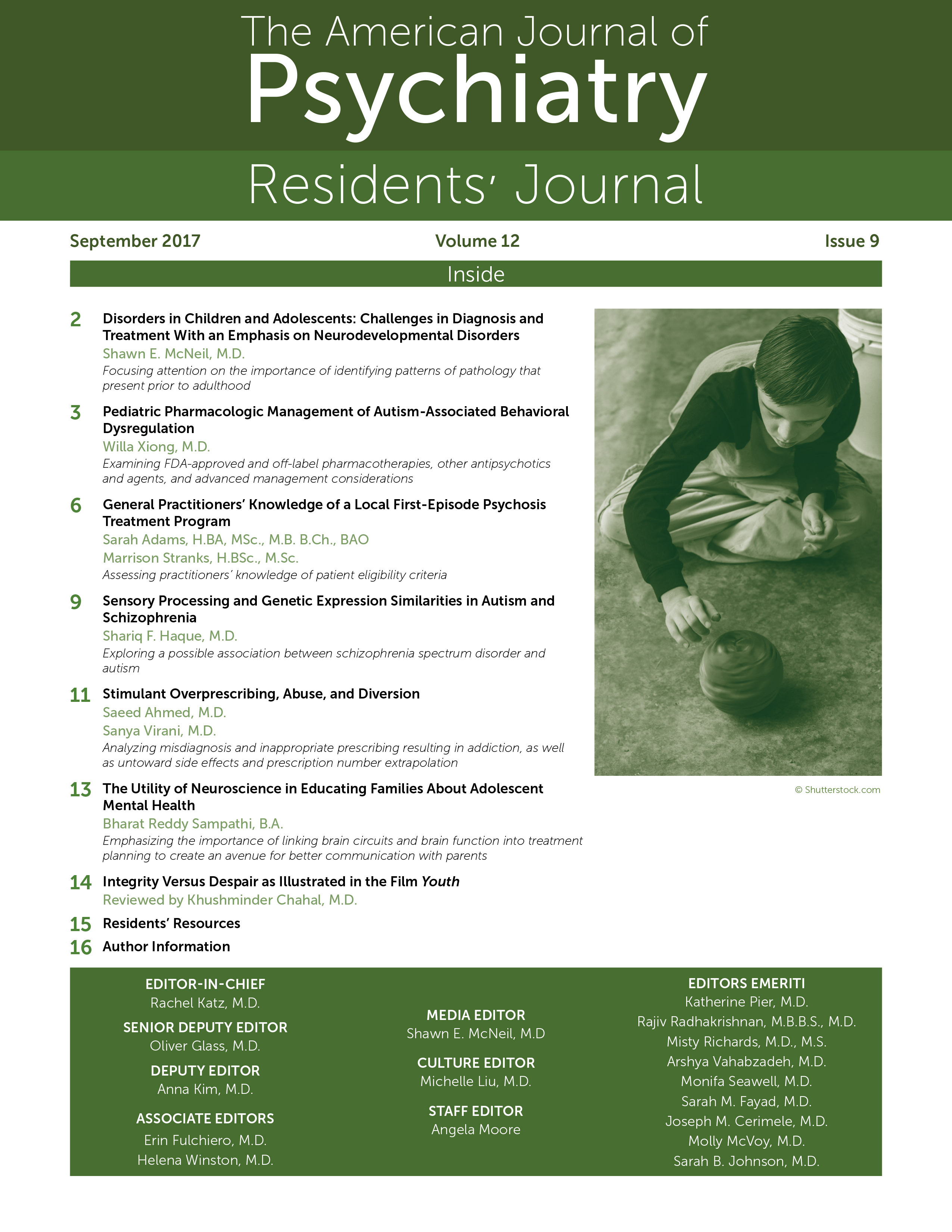Autism is a neurodevelopmental disorder with deficits in the domains of social communication and interaction, as well as restricted patterns of behaviors, interests, and activities (
1). Schizophrenia is a complex psychiatric disorder consisting of hallucinations and/or delusions, as well as impairments in cognition, including that of executive function (
2). Eugene Bleuler posited that autism was one of the four features characteristic of patients with schizophrenia (
3). Many of the negative symptoms of schizophrenia can mimic those of social withdrawal in autism. The distinction between the disorders was unclear until 1971 when the work of Israel Kolvin helped distinguish the two in
DSM-III (
1). It is understood that both schizophrenia and autism spectrum disorder (ASD) are characterized by derangements in sensory processing (
4,
5). Both ASD and schizophrenia share multiple phenotypic similarities and risk factors; they have been reported to occur together at elevated rates (
6). There exists literature on sensory processing deficits in both spectrums of disorders, and there are overlapping mechanisms implicated in the two. Recent research also describes shared genes, which are both downregulated in patients with autism and schizophrenia (
4), further reinforcing a link between the disorders.
Sensory systems are required for two purposes: to channel attention to critical regions of the outside world and, secondly, to decode that information to enable subsequent voluntary processing (
5). Impairments of sensory processing often lead to inappropriate responses to environmental stimuli, for instance, a patient with autism being unable to appropriately respond to social cues.
The case report below is of a young girl with autism who developed new-onset auditory hallucinations.
Case
“Samantha” is a 7-year-old girl with a history of ASD, who presented to the hospital, sent from school to the emergency department, for psychiatric evaluation after reporting hearing voices for the past 2 months telling her to hurt other people. The voices were persecutory in nature and would often tell her to harm her family. The child would refer to the voices as coming from an “imaginary friend, with fangs.” She had a normal developmental history, with milestones delayed for speech development. Her teachers had alerted her parents about her complaints of hearing voices. The family history was significant for schizophrenia on both the paternal and maternal sides. There was no significant medical history. Mental status examination revealed that the child was markedly withdrawn, covering her face when the interviewer asked her a question. She did demonstrate inability to maintain eye contact. She appeared morphologically without deficits. No visual hallucinations were described, but there existed auditory hallucinations of an imaginary friend that would tell the patient to hurt either herself or her family. While she never physically saw the imaginary friend, she believed that the imaginary friend had fangs. Medical workup in the emergency department, including CT head scan, complete blood count, and metabolic profile, were within normal limits.
A more thorough workup could have included an MRI, heavy metal testing, EEG, and lumbar puncture, in addition to genetic testing, to exclude other pathologies. In the absence of a family history of genetic defects, seizure history, exposure to heavy metals, or compromised vital signs, these examinations were deferred to be completed on an outpatient basis. The patient was referred for inpatient psychiatric hospitalization for stabilization and further evaluation and treatment.
Discussion
Sensory processing deficits are a cardinal symptom of ASD (
4). Adequate pre-attentive filtering of this information is necessary for higher cortical processing and then, in turn, for healthy brain function (
7). Sinclair et al. summarized sensory processing deficits in ASD, including abnormal auditory event-related potentials and reduced P50 suppression, a measure of sensory gating and reduced neurophysiological response to redundant stimuli, in children with ASD aged 3–8 (
4). Javitt and Freedman concluded that deficits exist in patients with schizophrenia for P50 suppression (
5). Such patients experience louder noises, misperception of sounds, and hallucinations (
5). Other studies also suggest that P50 deficits exist in both patients with schizophrenia and those with ASD (
7), consistent with impairments in excitatory and inhibitory balance (
5). Sensory processing deficits in autism can lead to differences in arousal to stimuli, which would, in turn, influence behavior (
7). An inability to maintain eye contact or to respond appropriately to questioning can be some manifestations.
While previous research exists suggesting an overlap between single-nucleotide genetic polymorphisms for both disorders (
5), there is a paucity of data at the level of genetic transcriptomes. Transcriptomes are defined as the total sum of messenger RNA expressed from a gene for specific cell lines. A recent transcriptome analysis conducted by Ellis et al. analyzed and compared RNA sequencing from the cortical brain tissue of deceased patients with that of control subjects with autism, schizophrenia, or bipolar disorder (
8). They found nine genes between both schizophrenia and autism that were differentially expressed, a finding that was statistically significant. Autism and schizophrenia both had a high number of genes that were similarly expressed. The genes in question code for neuronal synapse projection and formation (
8). The authors suggest a possible role for underlying neuronal development due to this correlation (
8) and therefore a possible neurobiological relationship for both disorders.
Conclusions
The association between schizophrenia spectrum disorders and ASD is known (
6). Both groups of disorders involve significant deficits in sensory processing. Advances in molecular genetic sequencing techniques are beginning to show a relationship between autism and schizophrenia. Individuals with autism have a 12.8% incidence of schizophrenia spectrum disorders (
6). While there exists some evidence of overlap between sensory processing deficits between schizophrenia and autism (
4,
5), as well as new genetic research (
8), further research and studies on gene transcriptomes are needed to identify additional overlaps and shed light on the neurobiological bases of both disorders.
Key Points/Clinical Pearls
Acknowledgments
The author thanks Sobia Nizami, M.D.
